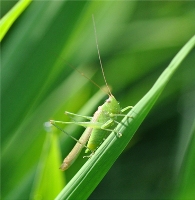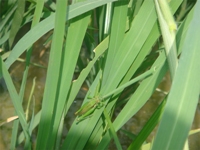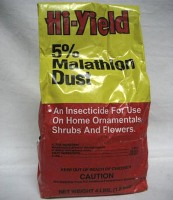|
Grass hopper
| Symptom of Damage : |
- Irregular feeding on seedlings and leaf blade
- Large portions of leaf edges consumed.
- Cutting of stem at panicle stage.
- Completely defoliate the plants leaving only the mid ribs.
- Presence of nymphs and adults feeding on paddy foliage.
|
 |
 |
| Irregular feeding on leaves |
Leaves are defoliated from the margin or tip irregularly |
|
| Top |
| Identification of pest : |
|
Scientific Name - Pelopidas mathias
- Egg :
The eggs are laid in batches of 30-40, hatch only in June to July on receipt of the monsoon rains. Eggs are yellowish and covered with gummy substrate that hardens into a waterproof coating.
- Nymph :
The nymphs feed on the grasses and paddy crop.
- Adult :
They grow into adults by August to September. Hieroglyphus banian (Large Grasshopper) measures about 1 ½ inch long. There are three transverse dark lines on the prothorax, which is helpful for identifying the pest. Oxya nitidula (Small grasshopper) is about one inch long and has a longitudinal brown streak on either side of the thorax. |
 Grass hopper Grass hopper |
 Grass hopper Grass hopper |
| |
|
| Top |
| Management Strategies: |
|
Cultural Methods:
- Flooding the stubbles, trimming the bunds, sweeping along the bunds and adult grass hoppers can be picked directly from the foliage at night because they are sluggish.
- Expose the eggs to be picked up by birds after ploughing and trim the bunds.
|
 |
 |
| Allow ducks into the field |
Flood the nursery |
|
Chemical Methods:
- Dusting the crop with 5-10% methyl parathion 2% @ 25-30 kg/ha.
- Dusting malathion 5% @ 20 kg/ha.
- Foliar sprays of insecticides can also control grasshoppers.
|
|
| Malathion dust |
|
Biological Methods:
- Scelionid wasps parasitize the eggs of short-horned grasshopper. A platystomatid fly and mite prey on the eggs of oriental migratory locust.
- Different species of ants feed on the nymphs and adults.
- They are also prey to birds, bats, field rats, mice, wild pigs, dogs, millipedes, fish, amphibia, reptiles and monkeys.
|
 |
 |
| Egg parasitoid - Telenomus remus |
Parasitic larva emerging from armyworm |
 |
|
| Pupal parasitoid-Netelia sp. |
|
| Top |
|


 Grass hopper
Grass hopper Grass hopper
Grass hopper





